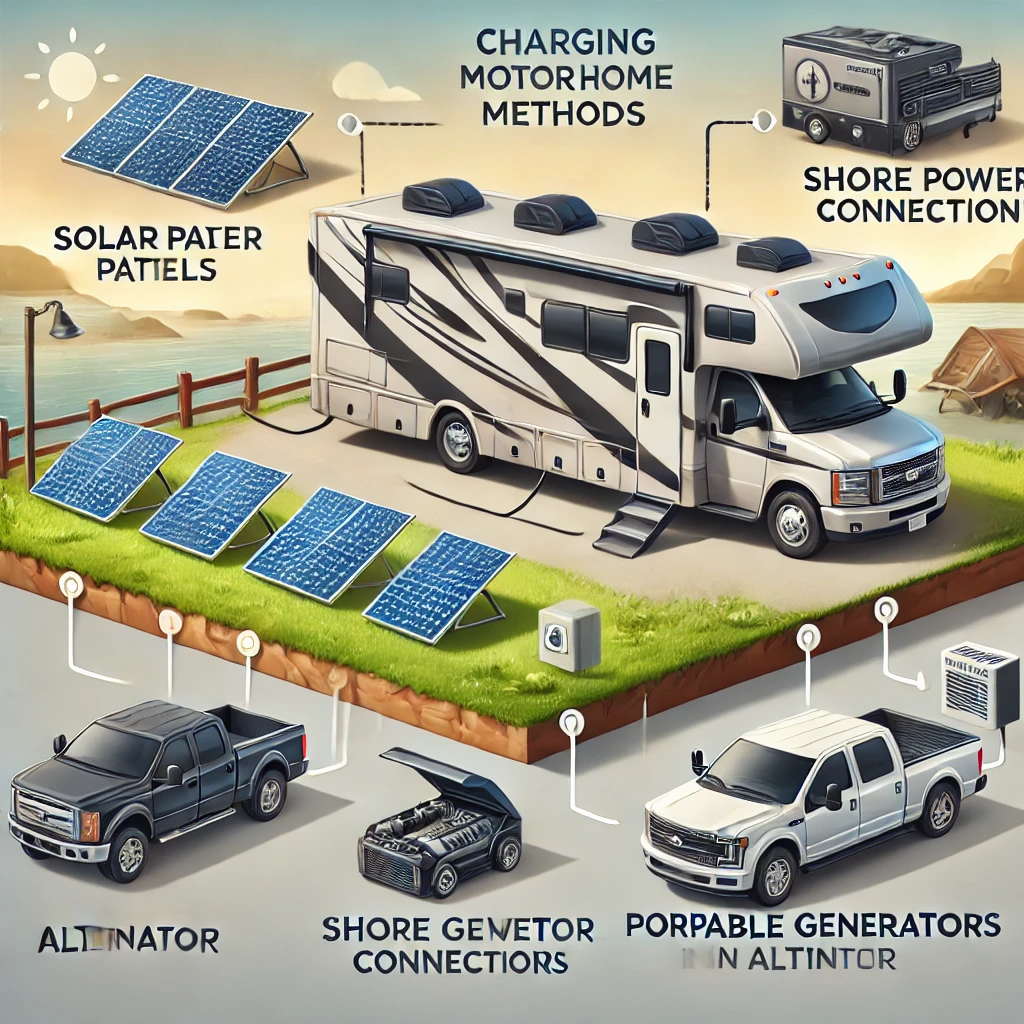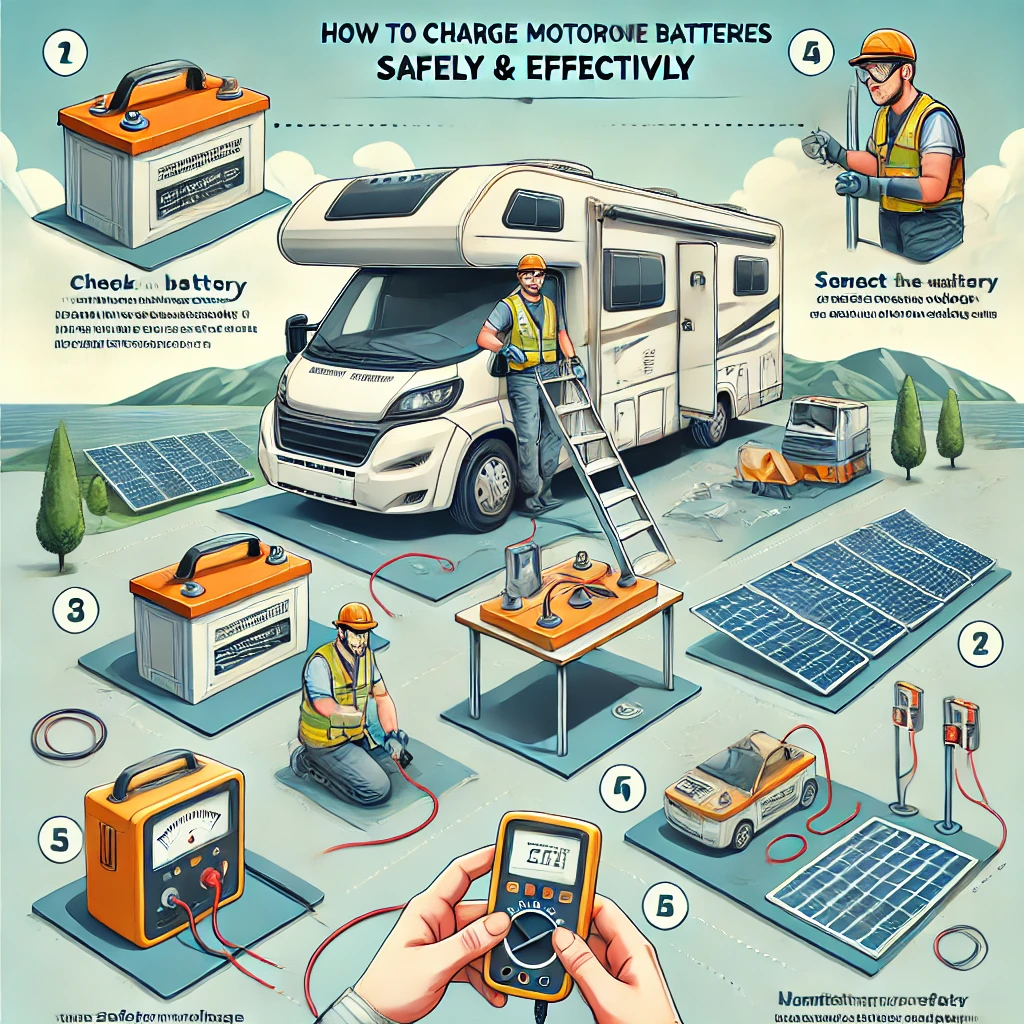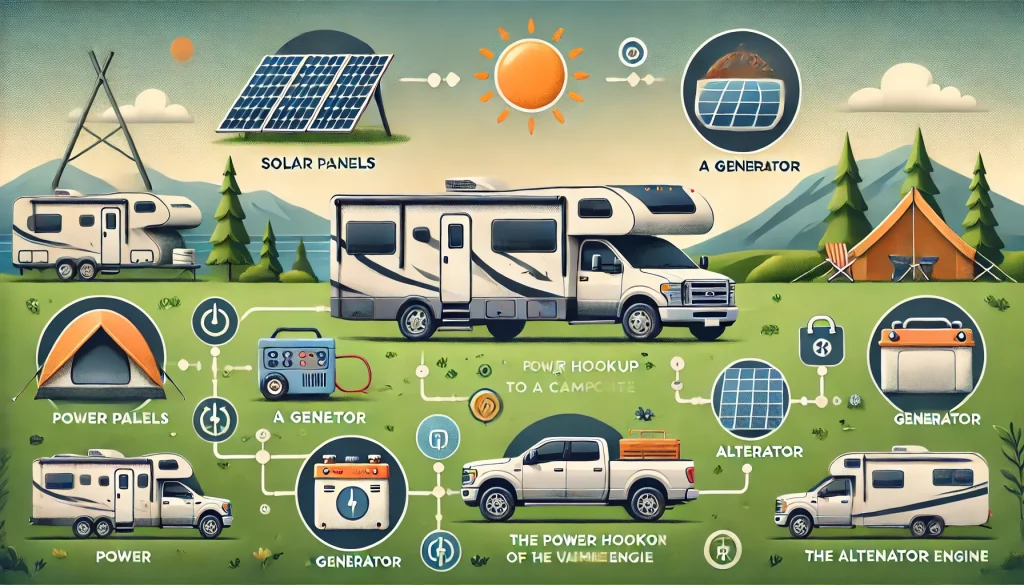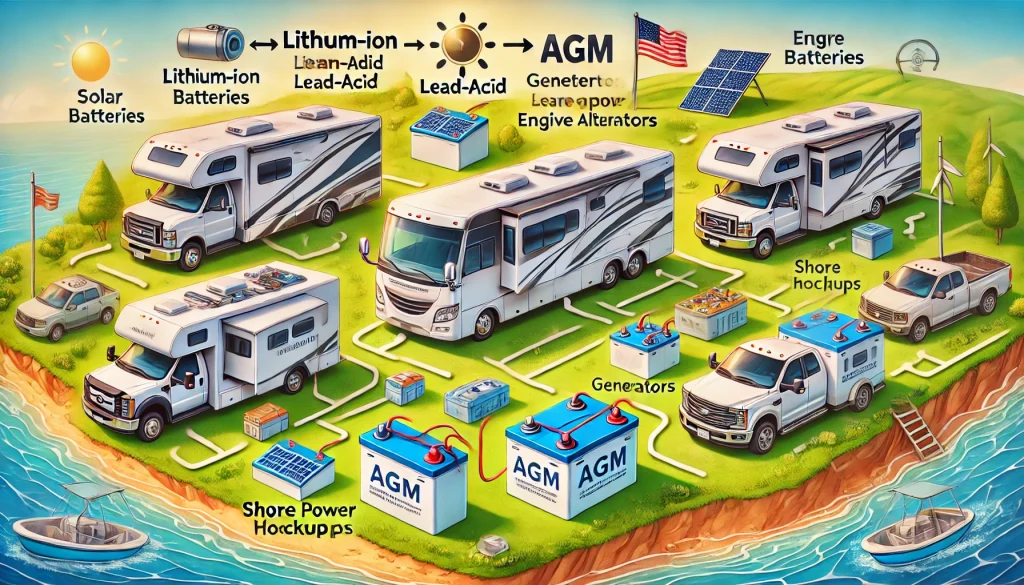Properly charging motorhome batteries is essential for ensuring your vehicle’s power systems run smoothly during your travels. Whether you’re using a motorhome for a weekend getaway or a long-term adventure, knowing how to charge its batteries efficiently can make a significant difference in your experience.
Factors Affecting the Lifespan of Motorhome Batteries
The lifespan of motorhome batteries is a crucial factor for any RV owner, as it directly impacts the reliability of your travels. Several factors can influence how long your battery lasts, ranging from maintenance practices to environmental conditions. Understanding these factors ensures you get the most out of your investment while avoiding unexpected failures.

Charging Practices
Proper charging habits play a significant role in maintaining your battery’s health.
Overcharging or Undercharging
- Overcharging: Consistently overcharging a battery leads to overheating and damages the internal components, reducing its lifespan.
- Undercharging: If a battery isn’t fully recharged, it can lead to sulfation—a buildup of lead sulfate crystals that diminishes capacity.
Using the Correct Charger
Always use a charger compatible with your battery type. For instance, lithium-ion batteries require specific chargers to avoid damage.
Depth of Discharge (DoD)
Depth of discharge refers to how much energy you use before recharging.
Impact of Deep Discharges
- Batteries that are frequently discharged below 50% of their capacity experience more wear and tear.
- Lithium batteries handle deep discharges better than lead-acid or AGM batteries, making them ideal for heavy energy users.
Environmental Conditions
Temperature and storage conditions significantly affect battery performance.
Extreme Temperatures
- High Temperatures: Excessive heat accelerates chemical reactions inside the battery, causing faster degradation.
- Cold Temperatures: Freezing conditions slow down the chemical reactions, reducing efficiency and capacity temporarily.
Proper Storage
- Always store batteries in a cool, dry place when not in use.
- Disconnect the battery to prevent phantom drains during extended storage periods.
Maintenance and Usage Habits
Proper maintenance practices ensure longevity for your motorhome battery.
Regular Inspections
- Check for corrosion on terminals and clean them regularly to ensure efficient power transfer.
- Inspect for cracks or leaks, which may indicate potential failure.
Avoiding High Loads
- Using multiple appliances simultaneously can strain your battery. Spread out usage to prevent overloading.
Battery Type and Quality
The type and quality of your motorhome battery also dictate its lifespan.
Higher-Quality Batteries Last Longer
- Lithium-ion batteries have a longer life cycle (up to 10 years) compared to AGM or gel batteries (3-5 years).
- Investing in a premium battery reduces long-term costs and enhances reliability.

What Is a Motorhome Converter, and Why Is It Important?
Role of the Converter in a Motorhome
A motorhome converter serves as the backbone of your vehicle’s power system. It ensures your 12-volt battery stays charged by converting 120-volt AC power from shore power or a generator.
- It powers lights, water pumps, and other 12-volt systems.
- It charges the leisure batteries for uninterrupted use during off-grid adventures.
Signs That Your Motorhome Converter Is Charging the Battery
Battery Voltage Levels Are Increasing
A quick way to check if the converter is charging the battery is to measure the battery’s voltage with a multimeter.
- How to Test Voltage
- Disconnect any loads on the battery.
- Set your multimeter to DC voltage mode.
- A fully charged battery should show 12.6 to 12.8 volts.
- When charging, the voltage should rise to 13.6 to 14.4 volts, indicating the converter is working.
Battery Monitor Shows Positive Charging Amps
A battery monitor, if installed, will display the charging current in amps. Positive numbers indicate the battery is receiving power from the converter.
- Tip
Check the monitor while connected to shore power or a generator. If the amp reading is consistently positive, your converter is functioning.
Lights and Appliances Operate Without Issue
If your 12-volt appliances and lights are working smoothly while the motorhome is plugged into shore power, it’s a good sign the converter is providing the necessary DC power.
No Error Lights or Alarms on the Control Panel
Modern motorhomes come with control panels that display battery and converter status. If there are no error warnings, the system is likely operating normally.

Common Issues if the Converter Isn’t Charging
Signs of a Faulty Converter
- Battery voltage remains static or drops while plugged into shore power.
- Appliances struggle to operate, or lights dim unexpectedly.
- Control panel displays error messages related to charging systems.
Troubleshooting Tips
- Inspect Fuses and Breakers: A blown fuse or tripped breaker can stop the converter from functioning.
- Test the Converter Output: Use a multimeter to measure the output voltage directly at the converter terminals. It should read between 13.6 and 14.4 volts.
- Check Battery Connections: Loose or corroded connections can disrupt the charging process.

How Long Do Motorhome Batteries Last?
Motorhome batteries are vital for powering appliances, lights, and other systems during your travels. However, like all batteries, their lifespan is limited and depends on several factors, including the type of battery, usage patterns, and maintenance practices. Let’s explore how long motorhome batteries last and tips to maximize their lifespan.
Average Lifespan of Motorhome Batteries
Different Types of Motorhome Batteries and Their Lifespan
The type of battery significantly impacts how long it will last.
- Lead-Acid Batteries
- Lifespan: 2 to 5 years with proper care.
- Maintenance: Regularly check and refill electrolyte levels, and avoid deep discharges.
- AGM (Absorbent Glass Mat) Batteries
- Lifespan: 4 to 7 years depending on usage.
- Maintenance: Minimal maintenance required; avoid frequent deep cycling.
- Lithium-Ion Batteries
- Lifespan: 8 to 15 years due to advanced technology.
- Maintenance: No maintenance needed; handle charging and discharging as recommended.
- Gel Batteries
- Lifespan: 3 to 7 years with proper use.
- Maintenance: Avoid overcharging, as gel batteries are sensitive to high voltages.

Signs It’s Time to Replace Your Motorhome Battery
Reduced Performance
If your battery drains faster than usual or struggles to power appliances, it may be nearing the end of its life.
Difficulty Holding a Charge
A battery that no longer holds a full charge despite proper charging is likely worn out.
Physical Damage
Swelling, cracks, or corrosion are indicators that a battery should be replaced immediately.
Age of the Battery
Even with minimal use, most batteries will need replacement after their average lifespan.
Tips to Extend Motorhome Battery Life
Avoid Deep Discharges
Keep the battery charge level above 50% to prevent strain, especially for lead-acid and AGM batteries.
Use Compatible Charging Equipment
Always use chargers recommended for your battery type to avoid overcharging or undercharging.
Perform Regular Inspections
Check for corrosion, loose connections, and electrolyte levels (if applicable). Address any issues immediately.
Store Properly During Off-Season
If not using your motorhome for an extended period, disconnect and store the battery in a controlled environment.
Methods to Charge Motorhome Batteries
Keeping your motorhome batteries charged ensures you stay powered up no matter where you travel.
Using a Shore Power Connection
Plugging into a campsite or RV park’s shore power is the simplest way to charge batteries. Most motorhomes come equipped with onboard chargers that automatically manage the charging process.
- Steps to Charge via Shore Power
- Connect your motorhome to the shore power outlet using a proper cable.
- Ensure the onboard charging system is switched on.
- Monitor the charging progress using the control panel.
Charging with Solar Panels
Solar panels offer an eco-friendly and cost-effective way to maintain battery levels during long stays off the grid.
- Tips for Solar Charging
- Use a solar charge controller to prevent overcharging.
- Position the panels to maximize sunlight exposure throughout the day.
- Invest in high-quality panels for better efficiency.
Alternator Charging While Driving
When driving, your motorhome’s alternator can recharge the batteries. However, this method primarily benefits the starter battery and may not fully charge leisure batteries.
Portable Generators
Portable generators are an excellent backup option when shore power or solar energy isn’t available. Ensure the generator is compatible with your motorhome’s power system.

How to Charge Motorhome Batteries Safely & Effectively
Charging your motorhome batteries safely and effectively is essential to ensure smooth travel and avoid unnecessary breakdowns. Whether you’re a seasoned RV enthusiast or a first-time traveler, understanding how to charge your motorhome batteries correctly will prolong their life and enhance your adventures.
Types of Motorhome Batteries
Before diving into charging techniques, it’s vital to understand the two main types of motorhome batteries.
Starter Batteries vs. Leisure Batteries
- Starter Batteries: Used to power the engine and designed for short bursts of energy.
- Leisure Batteries: Supply energy to onboard appliances, lights, and electronics.
Popular Battery Types in Motorhomes
- Lead-Acid Batteries: Common and cost-effective but need careful maintenance.
- Lithium-Ion Batteries: Lightweight, long-lasting, and charge faster but are more expensive.

Best Methods to Charge Motorhome Batteries
Using Shore Power for Safe Charging
Shore power is one of the safest and most convenient ways to charge motorhome batteries. Plugging into a campsite’s power supply provides reliable energy.
- How to Charge with Shore Power
- Connect the motorhome’s power cable to the shore power outlet.
- Ensure the onboard charging system is activated.
- Regularly monitor the battery status via the control panel.
Charging with Solar Panels
Solar panels are eco-friendly and excellent for maintaining battery levels during off-grid camping.
- Solar Panel Charging Tips
- Use a solar charge controller to prevent overcharging.
- Adjust panel angles to maximize sunlight exposure.
- Combine solar charging with other methods for consistent power.
Alternator Charging While Driving
Your motorhome’s alternator charges batteries as you drive. This method is highly effective for starter batteries but may need supplementation for leisure batteries.
Portable Generator Charging
Portable generators are a versatile backup option, especially when shore power or solar energy isn’t available.
- Tips for Generator Use
- Use only compatible generators to avoid system damage.
- Always operate generators outdoors to prevent carbon monoxide buildup.
Tips for Safe & Effective Battery Charging
Monitor Charging Levels
Avoid overcharging, as it can damage batteries. Use chargers with safety features like automatic shut-off.
Regular Maintenance Checks
Clean battery terminals and inspect for corrosion. For lead-acid batteries, check and refill electrolytes if necessary.
Invest in a Smart Charger
Smart chargers adapt to battery needs, ensuring safe and efficient charging every time.
Types of Motorhome Batteries
Understanding the type of battery in your motorhome is the first step. Motorhomes typically use one of the following battery types:
Starter Batteries vs. Leisure Batteries
- Starter Batteries: Provide a burst of power to start the engine.
- Leisure Batteries: Power appliances, lights, and other onboard equipment.
Lead-Acid vs. Lithium Batteries
- Lead-Acid Batteries: Affordable but require regular maintenance and careful charging.
- Lithium Batteries: Longer lifespan, faster charging, and lightweight but more expensive.

How to Charge Different Types of Batteries for Different Types of Motorhomes
Charging motorhome batteries effectively depends on the type of battery and motorhome you own. Each motorhome setup has unique power requirements, and understanding how to manage them ensures a hassle-free journey. This guide will help you navigate charging methods tailored to different battery and motorhome types.
Types of Motorhome Batteries
Before exploring charging methods, it’s crucial to identify the battery type in your motorhome.
Starter Batteries vs. Leisure Batteries
- Starter Batteries: Power the engine for ignition and require high cranking amps.
- Leisure Batteries: Provide energy for onboard appliances, lights, and systems.
Common Battery Types
- Lead-Acid Batteries: Cost-effective and widely used but require regular maintenance.
- AGM (Absorbent Glass Mat) Batteries: Spill-proof and maintenance-free, ideal for modern motorhomes.
- Lithium-Ion Batteries: Lightweight, durable, and charge faster but are more expensive.
Charging Methods for Different Motorhomes
Class A
A class motorhomes are luxurious and energy-demanding, often requiring robust charging systems.
- Shore Power Charging
- Plug into a 50-amp shore power outlet for efficient charging.
- Use an onboard converter to manage battery charging levels safely.
- Solar Panel Systems
- Large motorhomes benefit from high-capacity solar arrays.
- Ensure solar panels are paired with MPPT (Maximum Power Point Tracking) controllers for optimal charging.
Class B
Compact B class motorhomes often have fewer batteries and rely on versatile charging options.
- Alternator Charging
- Utilize the alternator while driving to recharge both starter and leisure batteries.
- Install a battery-to-battery charger to enhance efficiency.
- Portable Generators
- Compact generators are an excellent backup for B motorhomes.
- Choose an inverter generator to protect sensitive electronics.
Class C
Class C motorhomes balance size and energy needs, making them adaptable for various charging methods.
- Dual Charging Systems
- Use a split charging relay to charge both starter and leisure batteries simultaneously.
- Combine shore power and solar panels for consistent energy.
- Smart Chargers
- Invest in a multi-stage smart charger to safely manage charging levels.
- Ensure compatibility with AGM or lithium-ion batteries.

Tips for Charging Specific Battery Types
Lead-Acid Battery Charging Tips
- Avoid overcharging to prevent water loss and damage.
- Regularly check electrolyte levels and top up with distilled water.
AGM Battery Charging Tips
- Use a charger with a dedicated AGM mode to maintain optimal performance.
- Avoid deep discharges to extend battery life.
Lithium-Ion Battery Charging Tips
- Ensure the charger is compatible with lithium-ion chemistry.
- Take advantage of fast-charging capabilities without worrying about memory effects
Important Tips for Charging Motorhome Batteries
Avoid Overcharging
Overcharging can damage batteries and reduce their lifespan. Always use chargers with built-in safety features.
Regular Maintenance
Clean the terminals and check the electrolyte levels in lead-acid batteries to ensure optimal performance.
Use Smart Chargers
Smart chargers adjust the charging rate automatically, preventing overcharging and extending battery life.
Why Is My Motorhome Battery Draining While Plugged In?
A motorhome battery draining while plugged into shore power can be frustrating and alarming. Ideally, your motorhome’s converter should maintain or charge the battery when connected to a power source. However, several issues can cause the battery to lose power despite being plugged in. Let’s explore the most common reasons and solutions.

Common Causes of Motorhome Battery Draining
Faulty Converter or Charging System
The converter is responsible for transforming AC power into DC power to charge your motorhome battery. If it malfunctions, the battery may not receive sufficient power.
- Signs of a Faulty Converter
- Voltage at the battery terminals does not increase (should be 13.6–14.4 volts when charging).
- Appliances and lights flicker or dim unexpectedly.
- Solution
Test the converter’s output with a multimeter. If it’s not providing the required voltage, consider replacing or repairing it.
Parasitic Loads Draining the Battery
Even when plugged in, some devices or systems may draw power from the battery instead of using shore power.
- Common Parasitic Loads
- Alarm systems or CO2 detectors.
- Clocks or standby electronics.
- Faulty wiring or components.
- Solution
Disconnect unnecessary devices or appliances and install a battery disconnect switch to isolate the battery when not in use.
Overloaded Power System
If your motorhome has high energy demands, the converter might not be able to provide enough power for both charging the battery and running appliances.
- H3: Solution
Upgrade to a higher-capacity converter or reduce the load on the system by turning off non-essential appliances.
Damaged or Old Battery
An old or damaged battery may struggle to hold a charge, even when plugged into shore power.
- Signs of a Failing Battery
- Rapid loss of charge after disconnecting shore power.
- Swollen or corroded battery casing.
- Solution
Test the battery with a load tester. If it’s unable to hold a charge, it’s time for a replacement.
Poor Battery Maintenance
Lack of proper maintenance can lead to issues such as corrosion, low electrolyte levels (in lead-acid batteries), or dirty terminals.
- Solution
- Clean the battery terminals with a baking soda and water solution.
- Check electrolyte levels and top up with distilled water if necessary.
- Regularly inspect for wear and tear.
Improper Wiring or Connection Issues
Loose or corroded connections can prevent the battery from charging efficiently.
- Solution
Inspect all connections, ensuring they’re tight and free from corrosion. Replace damaged wires or connectors as needed.

Preventing Battery Drain While Plugged In
Install a Battery Monitor
A battery monitor provides real-time updates on your battery’s charge status, making it easier to spot issues early.
Use a Smart Charger or Maintainer
Smart chargers automatically regulate the charging process, preventing overcharging and ensuring the battery stays healthy.
Perform Regular Maintenance
Keep your motorhome’s power system in good condition by cleaning terminals, checking connections, and testing the converter periodically.
Common Issues with Different Types of Motorhome Batteries and Their Solutions
Motorhome batteries are critical for powering your adventures, but each type comes with specific challenges. Understanding these issues and their solutions ensures a longer lifespan, better performance, and fewer interruptions during your trips.
Lead-Acid Batteries
Lead-acid batteries, including flooded and AGM types, are widely used due to their affordability. However, they come with some drawbacks.
1: Sulfation
Sulfation occurs when lead sulfate crystals form on the battery plates due to undercharging or prolonged storage without maintenance.
Solution:
- Fully charge the battery regularly to avoid sulfate buildup.
- Use a desulfation charger to restore the battery if sulfation occurs.
2: Water Loss in Flooded Lead-Acid Batteries
Flooded lead-acid batteries lose water over time, especially under heavy use or overcharging.
Solution:
- Check water levels frequently and refill with distilled water as needed.
- Avoid overcharging by using a smart charger.
3: Weight and Bulkiness
Lead-acid batteries are heavy and take up considerable space.
Solution:
- Opt for AGM batteries if weight is a concern, as they are slightly lighter and require no maintenance.
AGM Batteries
AGM (Absorbent Glass Mat) batteries are a maintenance-free alternative to flooded lead-acid batteries but still present some challenges.
1: Overcharging Sensitivity
AGM batteries are sensitive to overcharging, which can cause overheating and damage.
Solution:
- Use a charger with voltage regulation designed for AGM batteries.
- Monitor charging cycles closely to prevent overcharging.
2: Cost vs. Performance
AGM batteries are more expensive than flooded lead-acid batteries but don’t always deliver a proportional performance boost.
Solution:
- Evaluate your energy needs and choose AGM only if maintenance-free operation and durability are top priorities.
Gel Batteries
Gel batteries are known for their safety and durability, but they also come with unique challenges.
1: Charging Limitations
Gel batteries require low charging currents; overcharging can cause irreversible damage.
Solution:
- Use a gel-compatible charger to prevent overcharging.
- Avoid fast charging, as it can harm gel batteries.
2: Cost
Gel batteries are expensive compared to other lead-acid types.
Solution:
- Invest in gel batteries only if you frequently operate in extreme temperatures or need a completely maintenance-free option.
Lithium-Ion Batteries
Lithium-ion batteries are popular for their efficiency and longevity, but they’re not without problems.
1: Cost
Lithium-ion batteries are the most expensive option upfront.
Solution:
- Consider the long-term savings due to their extended lifespan (5-10 years) and superior performance.
2: Temperature Sensitivity
Lithium-ion batteries struggle in extremely cold or hot environments, with performance dropping significantly.
Solution:
- Install a battery management system (BMS) to monitor and regulate temperature.
- Use insulation or heating pads for cold weather.
3: Compatibility with Existing Systems
Lithium batteries often require upgrades to the motorhome’s electrical system, such as converters and inverters.
Solution:
- Consult a professional to ensure your motorhome’s setup is compatible with lithium batteries.
General Battery Issues and Their Solutions
Regardless of battery type, certain issues are universal.
1: Parasitic Drains
Even when not in use, devices in your motorhome can drain the battery.
Solution:
- Disconnect the battery or use a master switch during storage.
- Invest in a solar trickle charger to keep the battery topped off.
2: Lack of Maintenance
Neglecting regular inspections leads to unexpected failures.
Solution:
- Check terminals for corrosion and clean them periodically.
- Test battery voltage regularly to ensure proper function.
3: Improper Storage
Storing batteries in extreme conditions shortens their lifespan.
Solution:
- Store batteries in a cool, dry place during off-season periods.
- Use a smart charger to maintain the charge level during storage.

Common Motorhome Battery Mistakes and Their Solutions
Motorhome batteries are essential for powering your appliances, lights, and other systems. However, improper handling or maintenance can lead to issues, reducing their efficiency and lifespan. Understanding the most common mistakes and how to avoid them can help you keep your motorhome batteries in excellent condition.
Common Mistakes Motorhome Owners Make
Overcharging the Battery
Overcharging occurs when the battery is charged beyond its capacity, leading to overheating, swelling, or damage.
- Why It Happens
- Using an incompatible charger.
- Leaving the battery connected to a constant power source without monitoring.
- Solution
- Use a smart charger that automatically adjusts the charging rate and prevents overcharging.
- Regularly check voltage levels during charging.
Deep Discharging the Battery
Allowing a battery to discharge below its safe limit can cause permanent damage, especially for lead-acid and AGM batteries.
- Why It Happens
- Forgetting to recharge the battery in time.
- Running high-demand appliances without monitoring the charge level.
- Solution
- Keep the battery charge above 50% for lead-acid batteries and avoid draining lithium-ion batteries below 20%.
- Use a battery monitor to track charge levels in real time.
Ignoring Maintenance
Neglecting routine maintenance can lead to issues such as corrosion, low electrolyte levels, or terminal damage.
- Why It Happens
- Lack of awareness or time.
- Assuming maintenance-free batteries need no attention.
- Solution
- Clean terminals regularly with a baking soda and water solution to prevent corrosion.
- Check electrolyte levels in lead-acid batteries and refill with distilled water if needed.
Using the Wrong Charger
Not all chargers are compatible with every battery type. Using an inappropriate charger can cause inefficiency or damage.
- Why It Happens
- Lack of understanding of battery specifications.
- Using one charger for multiple battery types.
- Solution
- Match the charger to your battery type (e.g., AGM, lithium-ion, or gel).
- Choose a charger with multiple modes for versatility.
Exposing the Battery to Extreme Temperatures
Batteries can lose efficiency or suffer permanent damage when exposed to very high or low temperatures.
- Why It Happens
- Leaving the motorhome in direct sunlight or freezing conditions.
- Failing to store the battery properly during the off-season.
- Solution
- Park in shaded or temperature-controlled areas.
- Store the battery in a cool, dry place when not in use.
Improper Wiring or Connections
Loose, corroded, or faulty connections can interrupt the charging process and reduce efficiency.
- Why It Happens
- Incorrect installation.
- Corrosion build-up over time.
- Solution
- Tighten all connections and clean terminals regularly.
- Use anti-corrosion sprays to prevent oxidation.
Failing to Monitor Parasitic Loads
Parasitic loads, such as clocks, alarms, or electronics in standby mode, can drain the battery even when not in use.
- Why It Happens
- Forgetting to disconnect small appliances.
- Not using a battery disconnect switch.
- Solution
- Install a battery disconnect switch to isolate the battery when the motorhome is idle.
- Identify and unplug unnecessary devices.
Neglecting to Upgrade Batteries When Needed
Using outdated or inappropriate batteries for your motorhome’s power demands can result in inefficiency.
- Why It Happens
- Sticking with the factory-installed battery without assessing needs.
- Avoiding the cost of an upgrade.
- Solution
- Evaluate your power usage and switch to a higher-capacity or more efficient battery type if needed.
- Consider lithium-ion batteries for longer life and better performance.
Best Battery Options for Different Types of Motorhomes
Choosing the right battery for your motorhome is crucial for ensuring a reliable and enjoyable travel experience. Whether you own a Class A, Class B, or Class C motorhome, or even a campervan, selecting the ideal battery can significantly impact your energy efficiency and performance. Below, we discuss the best battery options for various motorhome types and explain why they’re the perfect fit.
Best Battery for A class Motorhomes
Classes A motorhomes are luxury RVs with high energy demands, including appliances, air conditioning, and multiple devices.
Lithium-Ion Batteries for A Motorhomes
Lithium-ion batteries are the best option for A motorhomes due to their long lifespan, lightweight design, and superior energy density.
Reasons to Choose Lithium-Ion
- Higher Capacity: Lithium batteries can store more energy, supporting large appliances.
- Lightweight and Compact: Reduces overall vehicle weight, improving fuel efficiency.
- Longevity: Lasts 5-10 times longer than traditional lead-acid batteries.
Best Battery for B class Motorhomes (Campervans)
C B motorhomes prioritize compactness and efficiency. Energy needs are typically lower, but portability and durability are essential.
AGM Deep-Cycle Batteries for Classes B Motorhomes
AGM (Absorbent Glass Mat) deep-cycle batteries strike a balance between performance and cost for smaller motorhomes.
Reasons to Choose AGM Batteries
- Maintenance-Free: No need to top off water levels, ensuring convenience.
- Vibration Resistance: Perfect for compact vans often traveling on rough terrain.
- Affordable: Offers reliable power without breaking the bank.
Best Battery for Class C Motorhomes
Class C motorhomes blend the features of A and B models, requiring versatile and efficient power sources.
Gel Batteries for Class C Motorhomes
Gel batteries are ideal for Class C RVs because they provide steady power and can handle moderate energy demands.
Reasons to Choose Gel Batteries
- Leak-Proof Design: Ensures safety during travel.
- Reliable in Extreme Temperatures: Performs well in hot or cold climates.
- Eco-Friendly: Emits no harmful fumes, perfect for family trips.

Bonus Tip: Solar-Powered Battery Setups for Any Motorhome
Consider integrating solar panels with lithium or AGM batteries to enhance your motorhome’s off-grid capabilities. This setup reduces reliance on shore power, lowers environmental impact, and ensures consistent charging on sunny days.
Final Thoughts on Choosing the Best Motorhome Battery
When choosing the best battery for your motorhome, always consider your energy needs, travel habits, and budget. Whether you opt for lithium-ion for maximum performance or AGM for affordability, the right battery ensures your motorhome adventures are seamless and stress-free.
More related details will be available on Flamingo Motorhomes

